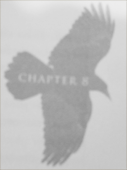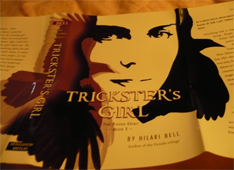 The reviews for Trickster’s Girl by Hilari Bell are all over the place. Personally, I enjoyed it. I thought Bell had a unique take on a Dystopian world that could very well become our future. She blended our fears about terrorists and new security guidelines with the fact that humans are slowly killing our planet. Throw in the awesome mythological Trickster and hints of Native American folklore and Trickster’s Girl becomes something utterly unique.
The reviews for Trickster’s Girl by Hilari Bell are all over the place. Personally, I enjoyed it. I thought Bell had a unique take on a Dystopian world that could very well become our future. She blended our fears about terrorists and new security guidelines with the fact that humans are slowly killing our planet. Throw in the awesome mythological Trickster and hints of Native American folklore and Trickster’s Girl becomes something utterly unique.The novel takes place about a hundred years after 9/11 and the world has become obsessed with security. On top of secure border checkpoints between countries, the USA also has border patrols between each state. To travel from state to state, citizens need special ID cards that are coded with their own DNA, making them impossible to forge. If going to another country, however, a special pass needs to be issued from the government. The USA seems to be more uptight than other countries. Take Canada, for example. Despite the border between the countries, state borders aren’t manned and people are freer to move about. While there is a lot of futuristic lingo thrown about, it’s described so naturally, it doesn’t feel like we’re being slammed with a wealth of new information. You can see this technology, can imagine it, can envision it in our own world. I never struggled to find a mental image of what was being described the way I have with other futuristic books full of new technology. I truly appreciated the way Bell spread this information over the course of the book instead of throwing it at us all at once.
Trickster’s Girl begins at a funeral. A teenager named Kelsa is mourning the loss of her father, who lost the fight against cancer. In this futuristic world, you can “rent” a resting place for your urn for about sixty years. Kelsa swaps out her father’s ashes for a mixture of flour, ashes, and some of her father’s beloved fishing tackle (to add weight) so that no one would notice the difference. She slips away from home at night after everyone is asleep and goes to the special place she’s always come with her dad to bury him beneath a cottonwood tree. Trees play an important part in this world. Bioterrorists have created a bioplague that has killed much of the South American rain forest and has made its way up to Mexico. If it can’t be stopped, the United States and Canada are next. Kelsa’s father went down to research the bioplague and contracted cancer soon after. Kelsa thinks the two events might be related.
After burying her father, Kelsa meets Raven, a strange boy who says he’s been looking for her. She thinks he’s dangerous, freaks out, and runs away. She begins seeing him everywhere and thinks he’s stalking her. It takes a while for him to convince her that he is the human form of Raven, the Native American form of the trickster spirit. He states that humans have been destroying their planet to an extent that its affecting the spirit world. Some of the spirits want the humans to clean up their own mess and save the planet while others want them to die off so that the world can begin anew. The way this concept is described reminds me of the movie Spirited Away (which I love), so it was easy to envision. The only way to begin saving the world is to travel to various nexus power spots and heal the leys in the earth. Only Kelsa can do this; spirits are unable to fix what humans broke. Many spirits are angry at the quest Kelsa and Raven embark on and the duo suddenly find themselves being hunted down.
The book is the first of two: The Raven Duet will conclude in 2012 with the release of Traitor’s Son. The end of the first book does have a lot of loose threads left hanging, which is one reason many people dislike the book. To me, it feels more like Bell split her novel into two chunks. We get half now and the rest next year, sort of like how The Lord of the Rings is really one book in three chunks. The other thing that frustrated readers was the lack of romance, but Bell has promised that there will be some in the second novel. The fact that Kelsa kept reflecting on Raven’s physical attributes but nothing happened made sense to me. Raven is very much a deity. Kelsa’s doing what he asks of her, but deep down, I think she’s afraid of him, especially because she knows he has his own agenda and is only using her to better his own world. For me, their relationship worked. I’ll be interested in seeing how Bell weaves the rest of the story together and ties everything up next year.
One last thing I wanted to point out to all of you is the fun chapter headings inside. Are you ready?

They’re inside a raven! How symbolic is that? Plus, Raven transforms into his namesake a few times, so it’s like you’re looking at the Trickster himself come the start of each new chapter. I also love the way the cover of the book uses mauve and white--and no other color. At first, I didn't think much of the cover, but the more I look at it, the more I fall in love with it. It's one of those images where you discover more things every time you look at it. On first glance, it's just a girl, right? But if you look really carefully, you'll see that the mauve making up her hair is also the wingspan of a raven and his head curves into the shadow of her eyes. There are also two other shades of mauve beneath the first to add dimension and each one repeats the head and wings pattern. Not only that, the image continues into the spine and onto the back cover, so when you look at the back cover, you see the raven's tail. The image also continues into the front inside cover flap when you flip it out, and while on first glance it's fly away hair, if you just look at the flap, it's a raven's head/beak and wings. Here's a look at the cover unfolded. Sorry for the lightning--it's dark and rainy this morning, so the light is kind of sucky for taking pictures and I'm too lazy to hook up my scanner. ^^;

[Review based on ARC edition courtesy of NetGalley; Photograph from my purchased copy of first hardback edition]
[This entry is part of Bookish Ardour's Reading Challenges' Dystopian Challenge of 2011. See how I've done so far here.]

Comments
Post a Comment
Thanks for taking the time to stop and comment! I appreciate it more than I can say. I try to respond to each one!